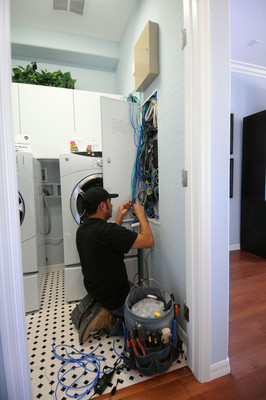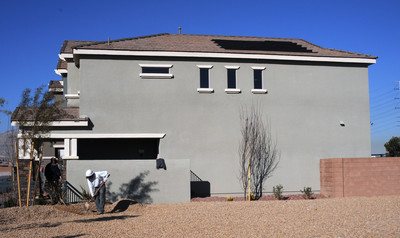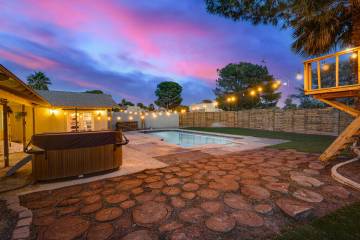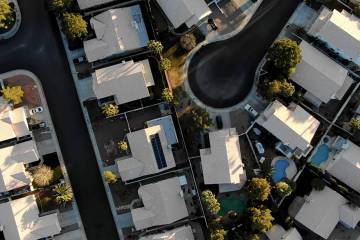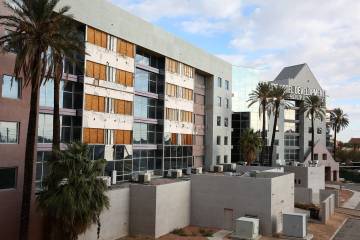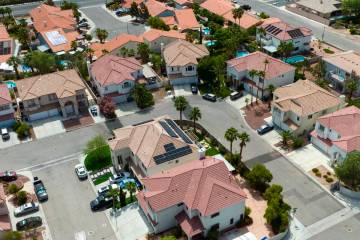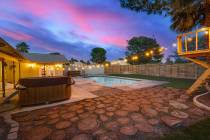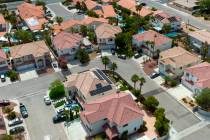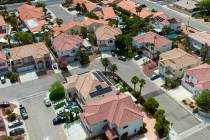New neighborhood features solar-power units
The latest new-home community from Pulte Homes includes some fairly typical features.
But on top of the granite countertops, wood cabinets and recessed lighting, Pulte has included solar-power systems as a standard item in every home at Villa Trieste in Summerlin.
After its private VIP opening today and its public grand opening Saturday, Villa Trieste could become one of the first local subdivisions to gain certification as a green community from a national green-building group, thanks partly to the solar-power setups gracing the roofs of all 185 of its homes. The goal of the solar-power systems, say Pulte officials, is to reduce residential energy use at Villa Trieste by 65 percent when compared with power consumption in conventional homes. The result could be lower energy use, particularly in the summer, when power demand surges as locals crank up their air conditioners.
Pulte officials said Villa Trieste would improve upon the company's existing efforts to conserve resources in their new communities.
"We've always built energy-efficient homes in Las Vegas, so for us, this was the logical next step as it relates to building quality, energy-efficient homes," said Scott Wright, Pulte's Las Vegas division president.
Even the federal government is watching how Villa Trieste fares. The U.S. Department of Energy granted $7 million to Pulte, in partnership with the University of Nevada, Las Vegas and local power company NV Energy, to help defray the cost of photovoltaics and a communications system to monitor the systems' efficiency.
Analysts say it's not the ideal time to launch a new-home community.
The market isn't exactly flush with prospective buyers who are willing or able to take out mortgages on new homes. Still, Wright said he expects Villa Trieste's prices and location -- starting from the mid-$200,000s in a high-profile master plan -- to help the community sell in a soft economy. The homes range from 1,487 square feet to 1,960 square feet, and they're all new floor plans.
Larry Murphy, president of local real estate research firm SalesTraq, said the local home-building market is "on the ropes," moving around 600 units a month. That's well below the 3,000 or so closings at the market's peak in 2005 and 2006.
Murphy also said consumers tend to show interest in green goods when energy prices jump, only to have that curiosity wane when fuel and power prices drop.
But Villa Trieste has a "dynamite location" in a planned community, and its starting price could lure in buyers, Murphy said.
"You've got to have somebody who understands and appreciates the fact that in the long run, they can save money with a solar-energy home," Murphy said. "If Pulte is able to deliver these homes at competitive prices, they ought to be good sellers."
For Pulte officials, Villa Trieste's environmental concessions were part business decision and part emphasis on doing the right thing. Wright said the neighborhood's ecoconscious construction should give it a marketing edge among consumers looking to minimize carbon footprints, but it also advances and promotes energy conservation on a broader scale.
"If you look at where we're headed in the future, it's a great educational process for people to come through and see these houses, and see the way solar works," Wright said. "It can help people start thinking about the bigger picture."
That bigger picture could include growing reliance on solar energy as the price of harnessing sun power comes down in the marketplace, Wright said.
This isn't the first time local builders have gone green.
Roughly two-thirds of new homes built in Las Vegas come with appliances certified for power efficiency through Energy Star, the federal Environmental Protection Agency's electricity-conservation program. The Las Vegas Valley's Energy Star penetration is twice that of any other American city. A number of local builders, Pulte among them, have mounted initiatives to boost energy and water conservation in the home. And in 2007, Pulte built two Anthem homes designed to test application of construction guidelines included in the U.S. Green Building Council's Leadership in Energy and Environmental Design for Homes program.
But Villa Trieste takes environmentally sensitive construction to a new level, said Robert Boehm, distinguished professor of mechanical engineering at the University of Nevada, Las Vegas and director of the its Energy Research Center. The community's focus on reducing peak energy demand has special significance in a region with sweltering summers. If Villa Trieste can help home builders and utility executives figure out how to reduce power-guzzling on the city's hottest days, then NV Energy could rely less on the expensive, last-minute spot-market power purchases that can increase electricity expenses. That could mean lower costs for consumers across the board, Boehm said.
Here's how Villa Trieste's homes work.
Each house begins with components of Pulte's Environments for Living program. Features include Energy Star appliances, Low-E windows that buffer against outdoor temperatures, leak-resistant duct work and air-conditioning with above-average efficiency ratios.
Add in Pulte's goal to land certification through LEED for Homes. LEED requires builders to meet dozens of guidelines for environmental friendliness in areas such as building materials, energy efficiency, water conservation, recycling of construction waste and land use. The U.S. Green Building Council will grade the homes after they're built and determine Villa Trieste's LEED status.
But the solar arrays and their accompanying feedback systems are Villa Trieste's signature element. Energy meters will provide real-time energy-use statistics for homeowners and utilities, and centralized battery storage at the power substation near the community will draw energy from homes in off-peak hours for use during peak periods to ease stress on the region's power grid.
What could make the photovoltaic system even more effective at saving power is what Wright called an in-home "dashboard" that lets residents compare their energy usage with consumption among their neighbors.
"It's like keeping up with the Joneses," Wright said. "People can say, 'We're using more energy than we should,' or, 'We're the most efficient house on the block.'"
The idea, and part of the federal grant's purpose, is to determine whether consumers' ability to monitor their energy use creates more incentives to cut kilowatts at home. Utility rate structures that allow consumers to pick fee plans based on peak energy use could eventually follow, Boehm said.
"This is a real trend-setting program because of the energy it could save," Boehm said.
Contact reporter Jennifer Robison at jrobison@reviewjournal.com or 702-380-4512.



